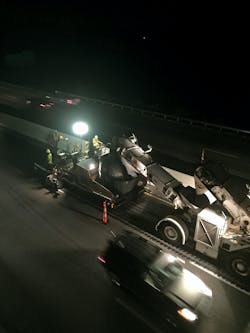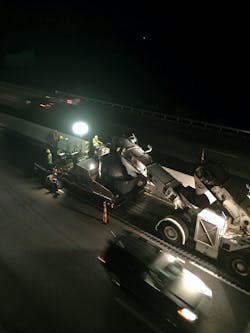By: Bill Wilson
It’s impossible to convince rain to come again another day. Sloan Construction tested this hypothesis more times than it needed to.
Dark storm clouds meant extra work for the contractor, at least at the start of the I-85 project in South Carolina. An 11.8-mile stretch of highway was in such bad shape, it should have required a declaration of emergency by the governor every time rain wreaked havoc with the pavement.
“It was wintertime when we got the project, and if we would get an inch of rain we would get potholes for 10 miles that would have to be replaced,” Casey Schwager, region manager for Sloan Construction, told Roads & Bridges. “It was scary how bad the whole thing could fall apart and how fast after just one rainstorm.”
To put an end to the fright, Sloan Construction recommended to the South Carolina DOT (SCDOT) to apply a 3-in. full-depth asphalt patch so the contractor could make it to the spring months when a complete reconstruction of the road could be performed. The section was full of joint and structural failures, and the failure rate was so high the route was a safety hazard for motorists. The last time work had been done on this section of I-85 was over 20 years ago when a portion was expanded from three lanes in each direction to four lanes. An asphalt overlay also was placed. When Sloan Construction arrived on the scene, the far right lane of the three-lane pavement was in the worst condition.
“The road was not in a safe condition when we got ahold of it, and we were in a race against time to get it all buttoned up. We needed to get it done fast. It was an A + B contract, and we said we would do the project in two years, which we did,” said Schwager. The project earned a 2018 Quality in Construction award from the National Asphalt Pavement Association.
The I-85 job, which ended up costing just over $42 million and was located between Greenville and Spartanburg, S.C., started in December of 2015 and was finished in late 2017, just in time to connect two more projects, one involving more paving work and the other improving the I-85/I-385 interchange.
“We needed to have this one section of interstate complete and safe for those other projects,” said Schwager.
The Intermediate B Special mix allowed Sloan crews to execute sub-base paving of the inside lanes in one lift.
Coming together
Work began on the inside two lanes, and Sloan operated in 4-mile segments (milling first followed by paving). Subcontractors Miller Group, Morrow, Ga., and PP&S, Piedmont, S.C., handled the milling work, which consisted of chewing off 4 in. of pavement 12 in. wide on the inside two lanes and a total of 9 in. on the outside lane. The two contractors worked simultaneously, one handling northbound work and the other southbound work. PP&S worked with Wirtgen W 2200 milling machines while Miller operated a CMI PR-1050. One milling machine was in operation to handle the two inside lanes, while two were used for the outside lane. A Roscoe Challenger V front-mount broom and a Caterpillar 262B skid-steer loader with a pickup broom were used for milling cleanup.
Sloan had two 400-tons-per-hour Gencor counterflow drum plants, each with an Astec baghouse, on the job, with the primary one located on the south end of the project. The contractor tested for volumetrics, A/C and gradation at the plant. Warm-mix asphalt was used on all three lifts, and the mix temperature at the asphalt plant was about 265°F; the surface course, which was an open-graded friction course specified by the SCDOT, sat at 275°F.
To make the new pavement more durable, Sloan injected innovation worthy of a commemorative plaque. The SCDOT wanted the sub-base paving of the two inside lanes done in two lifts, but Sloan thought up a new mix called Intermediate B Special, which allowed crews to execute in one lift.
“We had a lot of partnering with the SCDOT because this road was in such bad shape,” remarked Schwager, who did not want to provide the specs of the ground-breaking mix. “It was imperative that we replaced the structure as fast as possible, so we asked the DOT if we could prove we could get the appropriate density in one lift, and they agreed.”
The two inside lanes were paved first. Again, northbound and southbound work was done together. A Volvo PF5510 and PF4410 handled the asphalt paving duties and were fed by two Roadtec (SB2500 and MTV-1000) Shuttle Buggies. Two steel double-drum rollers (a Volvo DD118 and DD90) and a pneumatic rubber-tired roller (an Ingersoll Rand RT-125) handled sub-base compaction. A steel double-drum roller served as the breakout roller and made four passes. The Ingersoll-Rand RT-125 made two passes and was followed by the other steel double-drum roller, which served as the finishing roller and made four passes. Sloan provided SCDOT with cores at the beginning of the compaction work to prove they were hitting the right density range with the Intermediate B mix, and the density target was 98-102% of 142.9 PCF. The air void target for Intermediate B was 3.5% and the mix contained 30% reclaimed asphalt pavement (RAP).
The right lane did require two 4.5-in. lifts for the sub-base.
The intermediate course was called a Surface A mix, which was 2 in. thick. Again, Schwager kept the mix design concealed but did reveal it contained 3% air voids and 10% RAP. The density target was 92.2%. An A/C tack coat containing a PG 64-22 binder was applied before the surface layer, which was a 1-in. open-graded friction course that required three steel double-drum rollers for compaction. The machines operated next to each other, but were staggered a bit and were a few feet behind the asphalt paver. The line made one pass.
Because there were so many issues with the joint in the previous pavement, SCDOT wanted to make sure the new road would be strong where the mats met. According to Schwager, an A/C tack coat was used on the joints, which were getting the same density readings as the mainline.
“It wasn’t necessarily an airport specification as far as we had to core the joints and do testing on it, but we took extra care to make sure the joints were compacted properly.
“We would mill just a little bit into what we had on the night before when we were matching it back to make sure we had gotten everything and had a good vertical joint of good mix to tie into there,” said Schwager.
Sloan wanted to do all of the milling work at night and the paving work during the day on the weekends, but because the crew was already on a night shift during the week it was difficult to bounce them between night and day work, so it was decided to use longer shifts that started at around midnight and ended later in the day.
To check for density, Sloan used a nuclear gauge and was required to make 10 shots per shift. A profilograph was used to check for smoothness, and Sloan achieved a bonus for much of the work.
About The Author: Wilson is editorial director of Roads & Bridges.




